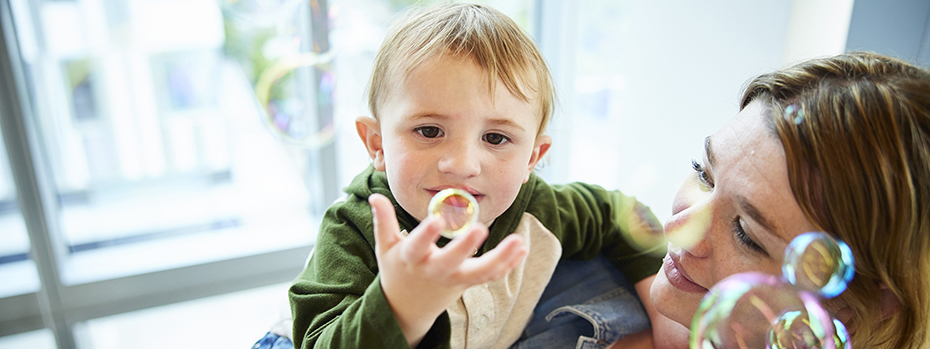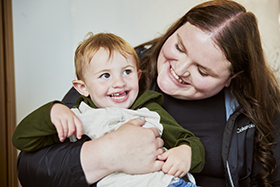Cleft Lip and Cleft Palate

OHSU Doernbecher Children’s Hospital is the most experienced and largest provider of cleft lip and cleft palate care in Oregon. We offer:
- A complete diagnosis and treatment plan for your child, beginning with evaluation before birth and supporting your child through the teen years.
- Expert care from specialists in more than 16 areas of medicine, speech and language pathology, orthodontics, dentistry and social services.
- Oregon’s only hospital to provide Nasoalveolar Molding (NAM). This presurgical reshaping of the gums, lip and nostrils can improve the results of cleft lip surgery and gum repair.
- A nurse coordinator who will work with you and answer all your questions about treatment, services and appointment scheduling.
Learn more about:
Understanding cleft lip and cleft palate
What are cleft lip and cleft palate?
Early in pregnancy, tissues that form a baby’s mouth and lips fuse together. A cleft, or gap, happens when these tissues do not align. The cleft can be on one side (unilateral) or on both sides (bilateral).
A cleft can occur in the lip or in the roof of the mouth, affecting the palate. Clefts range from small openings in the back of the mouth to large gaps affecting most of the roof of the mouth.
Clefts may occur in just the lip, just the palate, or both together. Cleft lip and cleft palate together is most common.
Cleft lips and cleft palates can cause:
- Problems with nursing or drinking from a bottle
- Speech and hearing problems
- Ear infections
- Teeth to be misaligned
Who gets cleft lip and cleft palate?
Cleft lip and cleft palate are common birth defects, and the most common medical issue affecting the head and neck. Each year in the United States, about 2,650 babies are born with a cleft palate and about 4,440 babies are born with a cleft lip, according to the Centers for Disease Control.
What causes cleft lip and cleft palate?
Heredity plays a role in cleft lip and cleft palate. You have a higher risk of having a baby with a cleft if you already had a baby with a cleft or if you or your partner has a cleft.
Cleft lip and cleft palate are usually not linked to environmental factors. But researchers continue to study behaviors that may affect a baby’s development in early pregnancy.
According to the CDC, these factors may increase the risk of cleft lip or cleft palate.
- Smoking: Parents who smoke during pregnancy have a higher risk of having a baby with a cleft.
- Diabetes: Parents with diabetes diagnosed before pregnancy (not gestational diabetes) have a higher risk of having a baby with a cleft.
- Epilepsy medications: Parents who use certain medicines to treat epilepsy, such as topiramate or valproic acid, during the first trimester have a higher risk of having a baby with a cleft.
Signs and symptoms of cleft lip and cleft palate
A cleft lip is often diagnosed during pregnancy by a routine ultrasound. A cleft palate is usually diagnosed after birth because the inside of a baby’s mouth can’t be seen on an ultrasound.
In rare cases, a cleft palate may only affect the soft palate (fleshy tissue at the back of the mouth). If this occurs, it may not be visible. Instead, the first sign of the cleft may be trouble latching on to the breast or bottle, or inconsistent suction when nursing.
Certain types of clefts may not be diagnosed until later in childhood. For example, a submucous cleft palate is a cleft in the roof of the mouth that is usually covered by skin.
Screening
Ultrasound technicians look for signs of a cleft lip during prenatal ultrasounds. At OHSU, we use a state-of-the-art, 3D ultrasound, making it easy to see signs of a cleft as early as possible.
If there are signs of a cleft lip, you can start learning about treatment options right away. Soon after your baby is born, your provider will examine the cleft lip and look for a cleft in the palate. Some types of clefts are covered with skin, making them hard to see. If your child’s care provider sees signs of a cleft, they can refer you to specialists like our team.
Types
The type of cleft your child has will determine the best treatment. Clefts may be:
- Incomplete: Partial fusion of the lip or palate
- Complete: No fusion of the lip or palate
A cleft lip may appear without a cleft palate or clefts may occur in combination. The most common combination is a cleft of the hard and soft palate and a cleft lip on one side.
Cleft lip
Cleft lips are grouped based on severity and the side of the lip where the cleft occurs:
- Incomplete unilateral: The cleft appears on one side of the lip and does not continue into the nose. The gum line (alveolus) also may be affected on this side.
- Complete unilateral: The cleft appears on one side of the lip and continues into the nose. The gum-line (alveolus) also may be affected on this side.
- Incomplete bilateral: The cleft affects both sides of the lip and does not continue into the nose.
- Complete bilateral: The cleft affects both sides of the lip and continues into the nose.
- Microform: A subtle cleft appears as a notch, groove, or scar on one or both sides of the lip. This cleft may not require surgery.
Bilateral clefts may also be asymmetrical. This means the cleft is complete on one side and incomplete on the other.
Cleft palate
Cleft palates are grouped into three types:
- Incomplete cleft palate: A cleft in the back of the mouth, in the soft palate.
- Complete cleft palate: A cleft affecting the hard and soft parts of the palate. The mouth and nose cavities are open to each other.
- Submucous cleft palate: A cleft in the muscles of the soft palate, but not in the lining of the palate. This cleft may not be seen in an exam.
Learn more
- Facts about Cleft Lip and Cleft Palate, Centers for Disease Control and Prevention
- Cleft Lip and Palate, National Institute of Dental and Craniofacial Research
- Cleft Lip and Palate Support, Smile Oregon
Location
OHSU Doernbecher Children’s Hospital
700 S.W. Campus Drive
Portland, OR 97239
Free parking for patients and visitors
For referring providers
Refer your patient to OHSU Doernbecher.
Call 503-494-8088 to:
- Seek provider-to-provider advice.
- Request education about plagiocephaly or other conditions.
Care from birth to adulthood

August and Grace Poirier share bonds as nephew and aunt and as cleft lip patients at OHSU.